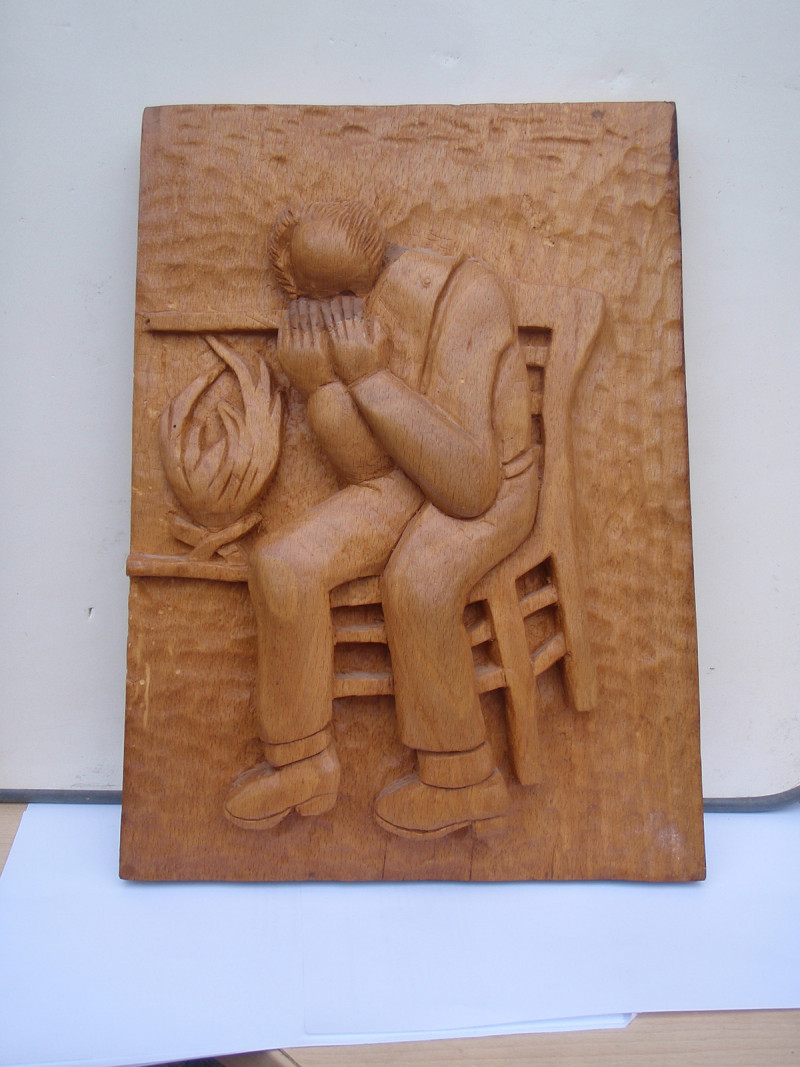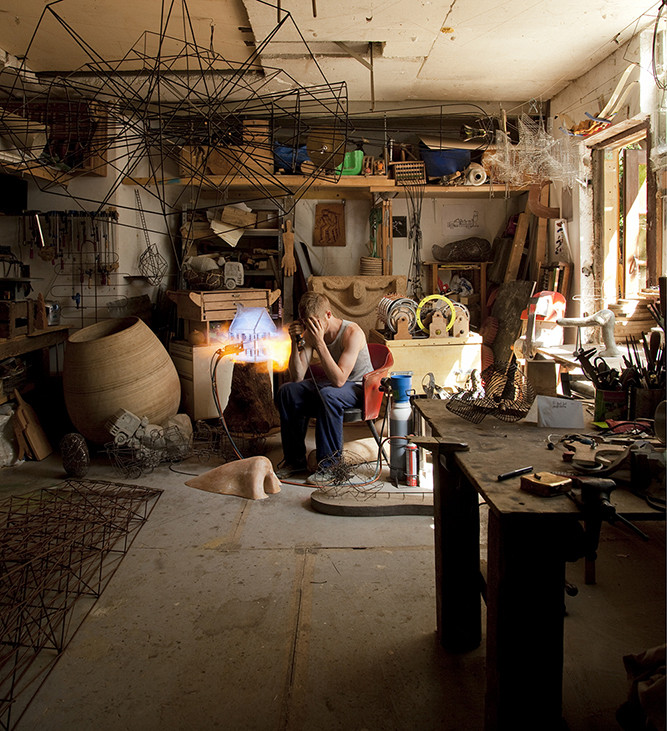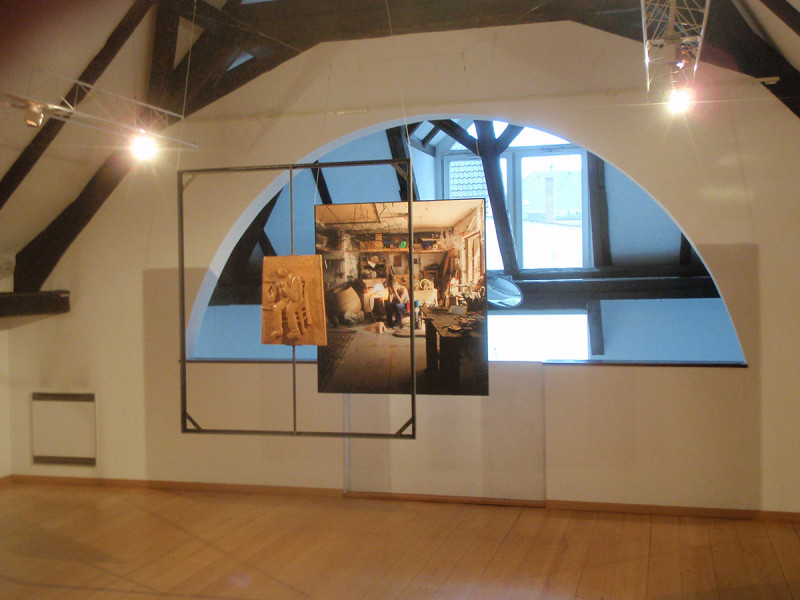Papi and I
PAPI ET MOI.
A l’occasion d’une exposition intitulée «HEIM» et regroupant plusieurs artistes de ma génération autour des questions de l’appartenance à une région historiquement aussi riche que l’Alsace, j’ai proposé un autoportrait, en hommage à celui de mon grand-père maternel, Alphonse Lerch.
Alphonse a construit sa maison à Souffelweyersheim, après s’être marié à Mathilde, ( voir PROJET BONHEUR) après avoir trouvé un emploi aux chèques postaux de Strasbourg, après avoir été enrôlé de force dans une guerre qui n’était pas la sienne. La violence qu’il a vécue sur le front
Russe l’a poursuivi toute sa vie, discrètement.
Une fois parvenu à la retraite, il s’est mis à sculpter le bois. Un univers intime a surgi, «naïf» et truculent, peuplé de paysans, de scènes religieuses et de lutins. Moi, j’étais très curieux de tout ce qui sortait de cet atelier, et en même temps ça paraissait complètement normal de passer son temps à faire ça. J’y ai appris le nom des outils qui me servent encore aujourd’hui.
Papi est mort à l’automne 2007, au pied d’un arbre dans lequel il était grimpé pour en faire tomber les fruits. Dans mon esprit, la brutalité de cet événement s’est teintée d’une poésie incroyablement absurde; j’ai réalisé que les fruits mûrissaient puis tombaient des arbres, comme les papis.
Peu après sa mort j’ai trouvé dans la cave ce petit bas-relief qui détonne dans sa production par l’impression très forte de recueillement qu’il dégage : un homme est représenté prenant sa tête dans ses mains, près du feu, sur une chaise. Il n’y a pas beaucoup d’espace autour de la figure centrale, le personnage a l’air à l’étroit dans son cadre. Au dos est écrit au marqueur noir cette phrase de Saint Augustin: «Tard je t’ai aimée, ô beauté. Tu étais au-dedans de moi, et moi j’étais encore au dehors de moi.»
J’ai découvert la profonde illumination intérieure qui animait mon grand-père, et le désarroi qui l’accompagnait. Je n’ai pas pu m’empêcher de le relier à un certain «caractère Alsacien», un peu timide, un peu secret, blessé.
Et puis me suis mis à considérer mon petit parcours d’artiste et d’Alsacien. J’ai cherché ce qui me reliait à ma famille, à la terre où je suis né. Et je me suis revu enfant, décidant tout naturellement d’être sculpteur comme Papi, sauf que je ne voulais pas attendre la retraite. Alors j’ai commencé à produire un tas de choses et je ne me suis jamais arrêté. Les objets sont mon médium, mon mode d’expression. C’est par là que je parle. Ils me représentent.
Je fais une image, pour une fois, pour voir. Pour me voir à travers lui. J’ai voulu interpréter le motif choisi
par mon Papi et prendre la même pose que lui, mais cette fois entouré de la masse de mes outils et sculptures, dans mon atelier. Aidé par mon ami le photographe Naohiro Ninomiya, et l’atelier 9 nous avons réalisé une grande belle impression, dans laquelle l’échelle de mon personnage s’ajuste sur celle du bas-relief.
Dans l’installation la photo était suspendue au plafond, derrière le bas-relief, et tous deux avaient le même cadre métallique, qui révélait le vide autour du personnage de mon aïeul.
Ce travail introspectif voudrait pourtant soulever ces questions: Pourquoi montrer un objet qu’on a façonné dans l’intimité ? Combien pèse l’hérédité ? Où se cache la violence ? Qu’est ce que ça veut dire, être Alsacien ? Etre artiste ?
PAPI AND I
On the occasion of an exhibition entitled «HEIM» featuring several artists of my generation around the question of belonging to a region culturally as rich as Alsace, I proposed a self-portrait in tribute to the one of my maternal grandfather, Alphonse Lerch.
Papi built his house in Souffelweyersheim, after married to Mathilde (see HAPPINESS PROJECT), after have worked as a postal employee, after having been enlisted by force in a war that was not his war.
The violence he absorbed on the Russian front purchased him his whole life, discreetly.
Once retired, he began to carve wood. An intimate universe raised, naive and earthy, full of peasant, religious or fairy sceneries. I was very curious about all this, and it seemed also quite normal to spent your time doing this.
I’ve learned the names of the tools I still use today.
Papi died at fall 2007, after falling from a tree he had climbed on, to pick up fruits. In my mind the brutality of this event tinted with an incredibly absurd poetry; I figured that fruits become mature then fall, like grandfathers.
Soon after his death I found in the cellar this little bas-relief which looks different from all his production, by the very strong impression of meditation it carries: a man is taking his head in his hands, near the fire on a chair. The picture almost touches the edges of the frame, the character seems very cramped. On the back, written with a thick black marker pen, this quote of St Augustine: «Late I have loved you, ö Beauty. You were within me, and I was outside myself.»I discovered the deep illumination that animated my grand- father, and the pendent disarray. I relied it to the Alsatian character, a little shy, secret, wounded.
Then I began considering my own route, as an artist and as an Alsatian. I looked for what linked me to my family, to the land where I was born.
I thought about the kid I was when I decided to become a sculptor like my Papi, without waiting like he did. So I began to produce pictures and objects, and never stopped. Now Objects are my main expression, i speak through them, they represent me.
I make a picture for once, to see. To see myself through him. I took the same pose as he did, but surrounded by my tools and sculptures, in my studio. With the help of my friend the photographer Naohiro Ninomiya and Atelier 9 we produced a big beautiful print, in which the size of my character is the same as the one on the bas-relief.
In the installation the photo was hanging from the ceiling behind the wood picture, with the same metallic frame, which revealed the emptiness around it.


